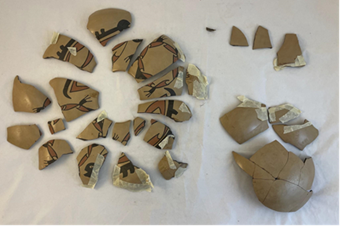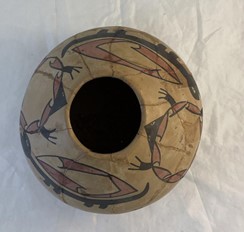Puebloan pottery artists develop their pottery using materials, techniques, forms, and designs passed down through their cultures, from their ancestors. Pottery production starts with clay from a traditional family source, which is a manifestation of their cultural connection with the earth. The process of making the pottery often involves the help of family members, who gather and process the clay and pigments and assist with the firing of the pottery.
The form of a traditional vessel often derives from its function. This vessel, with its bulbous shape and small mouth, is made in the form of a water jar. This form keeps the water from easily spilling, and the porous, unglazed pottery material allows water to evaporate through the vessel walls; while this may seem counterproductive, the evaporation serves to cool the water in the vessel.
While Puebloan artists typically use traditional motifs and pigment colors, they make their own unique stylistic choices. For example, the turtle motif on this vessel often refers to water, and it may also represent perseverance and a long life for the user. The artist has rendered the turtle twice in the traditional view from above, but then alternates these images with the turtle rendered in an unusual side view.

Puebloan cultures
Late 20th to Early 21st centuries
Ceramic and pigment, before reconstruction:
Largest piece: L. 6.2 cm x W. 3 mm x H. 10.5 cm
Smallest piece: L. 6 mm x W. 3 mm x H. 2 cm
BFPC collection #2017.15

Puebloan cultures
Late 20th to Early 21st centuries
Ceramic and pigment, before reconstruction:
Largest piece: L. 6.2 cm x W. 3 mm x H. 10.5 cm
Smallest piece: L. 6 mm x W. 3 mm x H. 2 cm
BFPC collection #2017.15
For more information, you may contact the researcher(s) noted in the title of this exhibit entry, or Dr. Billie Follensbee, the professor of the course, at BillieFollensbee@MissouriState.edu
